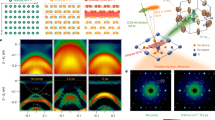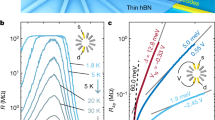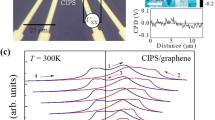Abstract
The Nernst effect has recently emerged as a very sensitive, yet poorly understood, probe of electron organization in solids1,2,3,4. Graphene, a single layer of carbon atoms set in a honeycomb lattice, embeds a two-dimensional gas of massless electrons5 and hosts a particular version of the quantum Hall effect6,7. Recent experimental investigations of its thermoelectric response8,9,10 are in agreement with the theory conceived for a two-dimensional electron system in the quantum Hall regime11,12. Here, we report on a study of graphite13, a macroscopic stack of graphene layers, which establishes a fundamental link between the dimensionality of an electronic system and its Nernst response. In striking contrast with the single-layer case, the Nernst signal sharply peaks whenever a Landau level meets the Fermi level. Thus, the degrees of freedom provided by finite interlayer coupling lead to an enhanced thermoelectric response in the vicinity of the quantum limit. As Landau quantization slices a three-dimensional Fermi surface, each intersection of a Landau level with the Fermi level modifies the Fermi-surface topology. According to our results, the most prominent signature of such a topological phase transition emerges in the transverse thermoelectric response.
This is a preview of subscription content, access via your institution
Access options
Subscribe to this journal
Receive 12 print issues and online access
$259.00 per year
only $21.58 per issue
Buy this article
- Purchase on SpringerLink
- Instant access to full article PDF
Prices may be subject to local taxes which are calculated during checkout




Similar content being viewed by others
References
Wang, Y., Li, L. & Ong, N. P. Nernst effect in high-Tc superconductors. Phys. Rev. B 73, 024510 (2006).
Pourret, A. et al. Observation of the Nernst signal generated by fluctuating Cooper pairs. Nature Phys. 2, 683–686 (2006).
Behnia, K. The Nernst effect and the boundaries of the Fermi liquid picture. J. Phys. Condens. Matter 21, 113101 (2009).
Cyr-Choinière, O. et al. Enhancement of the Nernst effect by stripe order in a high-Tc superconductor. Nature 458, 743–745 (2009).
Geim, A. K. & Novoselov, K. S. The rise of graphene. Nature Mater. 6, 183–191 (2007).
Novoselov, K. S. et al. Two-dimensional gas of massless Dirac fermions in graphene. Nature 438, 197–200 (2005).
Zhang, Y. et al. Experimental observation of the quantum Hall effect and Berry’s phase in graphene. Nature 438, 201–204 (2005).
Zuev, Y. M., Chang, W. & Kim, P. Thermoelectric and magnetothermoelectric transport measurements of graphene. Phys. Rev. Lett. 102, 096807 (2009).
Wei, P. et al. Anomalous thermoelectric transport of Dirac particles in graphene. Phys. Rev. Lett. 102, 166808 (2009).
Checkelsky, J. G. & Ong, N. P. Thermopower and Nernst effect in graphene in a magnetic field. Phys. Rev. B 80, 081413(R) (2009).
Jonson, M. & Grivin, S. M. Thermoelectric effect in a weakly disordered inversion layer subject to a quantizing magnetic field. Phys. Rev. B 29, 1939–1946 (1984).
Oji, J. Thermomagnetic effects in two-dimensional electron systems. J. Phys. C 17, 3059–3066 (1984).
Brandt, N. B., Chudinovn, S. M. & Ponomarev, Ya. G. Semimetals I. Graphite and its Compounds (Elsevier, 1988).
Behnia, K., Méasson, M.-A. & Kopelevich, Y. Oscillating Nernst–Ettingshausen effect in bismuth across the quantum limit. Phys. Rev. Lett. 98, 166602 (2007).
Lifshitz, I. M. Anomalies of electron characteristics of a metal in the high pressure region. JETP 11, 1130–1135 (1960).
Blanter, Ya. M., Kaganov, M. I., Pantsulaya, A. V. & Varlamov, A. A. The theory of electronic topological transitions. Phys. Rep. 245, 159–257 (1994).
Soule, D. E., McClure, J. W. & Smith, L. B. Study of the Shubnikov–de Haas effect. Determination of the Fermi surfaces in graphite. Phys. Rev. 134, A453–A470 (1964).
Williamson, S. J., Foner, S. & Dresselhaus, M. S. de Haas–van Alphen effect in pyrolytic and single-crystal graphite. Phys. Rev. 140, A1429–A1447 (1965).
Woollam, J. A. Graphite carrier locations and quantum transport to 10 T (100 kG). Phys. Rev. B 3, 1148–1158 (1971).
Slonczewski, J. C. & Weiss, P. R. Band structure of graphite. Phys. Rev. 109, 272–279 (1958).
McClure, J. W. Band structure of graphite and de Haas–van Alphen effect. Phys. Rev. 108, 612–618 (1957).
Luk’yanchuk, I. A. & Kopelevich, Y. Dirac and normal fermions in graphite and graphene: Implications of the quantum Hall effect. Phys. Rev. Lett. 97, 256801 (2006).
Schneider, J. M. et al. Consistent interpretation of the low-temperature magnetotransport in graphite using the Slonczewski–Weiss–McClure 3D band-structure calculations. Phys. Rev. Lett. 102, 166403 (2009).
Behnia, K., Méasson, M.-A. & Kopelevich, Y. Nernst effect in semimetals: The effective mass and the figure of merit. Phys. Rev. Lett. 98, 076603 (2007).
Sugihara, K. & Ono, S. Galvanometric properties of graphite at low temperatures. J. Phys. Soc. Jpn 21, 631–637 (1966).
Fletcher, R. Magnetothermoelectric effects in semiconductor systems. Semicond. Sci. Technol. 14, R1–R15 (1999).
Gusynin, V. P. & Sharapov, S. G. Transport of Dirac quasiparticles in graphene: Hall and optical conductivities. Phys. Rev. B 73, 245411 (2006).
Livanov, D. V. Hall and Nernst effects in some models of anisotropic metals. Phys. Rev. B 60, 13439–13443 (1999).
Behnia, K., Balicas, L. & Kopelevich, Y. Signatures of electron fractionalization in ultraquantum bismuth. Science 317, 1729–1731 (2007).
Acknowledgements
We thank A. Varlamov for stimulating discussions and in particular for introducing ref.16 to us. This work is supported by the Agence Nationale de Recherche (ANR-08-BLAN-0121-02) as a part of the DELICE project in France and by FAPESP and CNPq in Brazil. Z.Z. acknowledges a scholarship granted by the China Scholarship Council.
Author information
Authors and Affiliations
Contributions
Z.Z. (assisted by H.Y. and B.F.) carried out the experiment and (assisted by K.B.) analysed the data and prepared the figures. Y.K. initiated this work. K.B. wrote the paper.
Corresponding author
Supplementary information
Supplementary Information
Supplementary Information (PDF 959 kb)
Rights and permissions
About this article
Cite this article
Zhu, Z., Yang, H., Fauqué, B. et al. Nernst effect and dimensionality in the quantum limit. Nature Phys 6, 26–29 (2010). https://doi.org/10.1038/nphys1437
Received:
Accepted:
Published:
Issue date:
DOI: https://doi.org/10.1038/nphys1437
This article is cited by
-
Unveiling the double-peak structure of quantum oscillations in the specific heat
Nature Communications (2023)
-
Ultrafast photothermoelectric effect in Dirac semimetallic Cd3As2 revealed by terahertz emission
Nature Communications (2022)
-
Giant Seebeck effect across the field-induced metal-insulator transition of InAs
npj Quantum Materials (2020)
-
Quantized thermoelectric Hall effect induces giant power factor in a topological semimetal
Nature Communications (2020)
-
Zeeman splitting and dynamical mass generation in Dirac semimetal ZrTe5
Nature Communications (2016)



